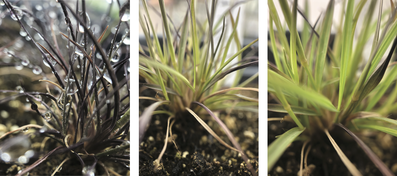Theme 4: evolutionary dynamics
Desiccation tolerance, from molecules to ecosystems
|
genetic determinants underlying desiccation tolerance
 (A) Spatial A. thaliana seed germination behavior responding to temperature and rainfall patterns. (B) Color legend.
(A) Spatial A. thaliana seed germination behavior responding to temperature and rainfall patterns. (B) Color legend.
Populations of species that have broad geographic distributions can experience dramatic differences in water availability and cycles of rainfall abundance and aridity. Studying genomic differences among such distinct populations has identified genes involved in adaptive fine-tuning to the local environment, including seed temperature sensing genes like DOG5 in Arabidopsis thaliana and FLOE1, which we recently discovered to be associated with precipitation gradients (Dorone, et al. 2021). We propose to create a genome-wide association panel of seed responses to hydration-dehydration-hydration cycles in the field by leveraging the 1001 Arabidopsis Genomes resource.
new system for evolutionary genetics of desiccation tolerance
 Rehydration time course of Microchloa caffra. Image credit: Rose Marks
Rehydration time course of Microchloa caffra. Image credit: Rose Marks
Many resurrection plants are widely distributed with stark differences in elevation, precipitation, and temperature across their native range. Levels of desiccation tolerance presumably vary in concordance, but little is known about the natural diversity of resurrection plants. Here, we will investigate the patterns and consequences of intraspecific variation in desiccation tolerance, genotype by environment interactions, and local adaptation in the resurrection plant Microchloa caffra—one of the most abundant and yet under-studied resurrection grasses in Sub-Saharan Africa.
conserved & lineage-specific molecular responses to anhydrobiosis
Despite their phylogenetic diversity and unique life histories, a core set of metabolic, physiological, and structural changes have been observed in plants during desiccation in all tolerant lineages. The repeated and recurrent evolution of desiccation tolerance, partially conserved cellular responses, and overlapping ecological distributions suggests this trait evolved convergently through rewiring similar pathways. We hypothesize the ancestral mechanisms that enabled terrestrialization have been retained and repurposed throughout evolution, forming the basis of complex desiccation tolerance mechanisms. We will test our hypotheses on the origin, diversification, and evolution of desiccation tolerance mechanisms through leveraging large-scale ecological, evolutionary, genomic, and systems-level datasets across desiccation tolerant lineages spanning ~1.5 billion years of divergence.














